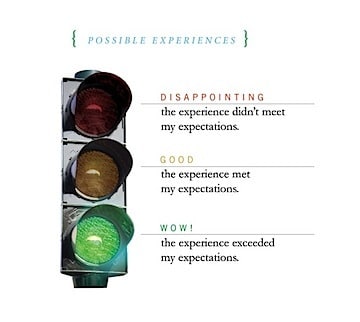Recently, while on vacation, Gail and I saw two movies in the theater. (I’m not going to mention which movies, because whether you agree with my assessment is not the point.) Both movies sounded great. We eagerly looked forward to seeing them.

Unfortunately, we were disappointed in both movies. We left the theater regretting that we had made the investment in terms of money and the time.On the morning after the second movie, I went running. I began to think about my experience of disappointment with the movies. Suddenly, I had a revelation. The essence of WOW is this:
That doesn’t sound all that profound. But I think it has big implications for those of us who are committed to creating WOW experiences.
First of all, each person brings a set of expectations to each experience. Those expectations may be conscious or unconscious. They may be general or specific. They may be vague or clearly defined. Regardless, no customer comes to any experience without some kind of expectation. It’s just the way the human mind works.
In the case of the two movies I described above, several things shaped my expectations:
- My previous experience with the series (both were sequels)
- My familiarity with the book on which the second movie was based
- The movie trailers I had seen
- The few reviews I read online before seeing the movies
- The recommendations of a few close friends who had seen the movies
The point is that I came to each movie with a very defined set of expectations. Note also the use of the word “current” in my definition. My expectations for movies were different twenty years ago. They were even different a few years ago, before movies like The Lord of the Rings trilogy. Each successive WOW creates a new threshold for the next one.
In any event, I could have had three different experiences relative to my expectations:

Please note that only the green light is a WOW experience. The other two are NOT-WOW. Good is not good enough. If you are committed to creating a WOW experience, then only the green light is an acceptable outcome.
By the way, you don’t have to make every experience in life a WOW. If everything is a WOW, then pretty soon, nothing is a WOW. But you must be able to identify which experiences you want to make a WOW, and then have a process—or a “technology”—for creating that outcome. I call this “the how of WOW.” It involves asking five questions:
- What is the experience I want to create or transform into a WOW?
- How will the customer feel as a result of this experience? (In other words, what is the specific outcome we want to create?)
- What specific expectations does the typical customer bring to this experience?
- What does failing to meet customers’ expectations for this experience look like?
- What does exceeding customers’ expectations for this experience look like?
These questions can be used on your own or in a group setting to create a WOW conversation.
To illustrate, let’s say that we have realized that our product is more than the artifact we produce (e.g., inspirational books). It is the total customer experience, and it begins from the moment our customers walk into our corporate lobby. We determine that we want to make this a WOW experience. Here’s one way we could apply the questions:
- What is the experience I want to create or transform into a WOW? The customer’s lobby experience.
- How will the customer feel as a result of this experience? (In other words, what is the specific outcome we want to create?) They feel that we must be an extraordinary company because they have never had a lobby experience like this. They assume that we are somehow really different, and they can’t wait to experience more.
- What specific expectations does the typical customer bring to this experience?
- They expect the lobby to be clean, neat, and well lit.
- They expect the receptionist to be friendly and professional.
- They expect the receptionist to call the appropriate person and notify them they have a visitor.
- They expect to be asked to sign-in and put on a visitor’s name badge.
- They expect to be seated while they wait.
- They expect to wait 5–10 minutes before being admitted.
- They expect a few, probably slightly out-of-date magazines to thumb through.
- They expect to be met by the person they are meeting.
- What does failing to meet customers’ expectations for this experience look like?
- The lobby is dirty, messy, or dimly lit.
- The receptionist is distracted, cold, or rude.
- The person gives them the third degree, almost as if they are asking them to prove that they have an appointment.
- They are told (not asked) to sign in and handed a cheap, adhesive label. They are told to print their name on it. They affix the label to their coat, but it keeps falling off.
- There is no where to sit or all the seats are occupied. They must stand.
- They have to wait for more than 10 minutes.
- There is either nothing to read or the magazines are badly worn and outdated.
- They are told where to go and have to navigate a building they have never been in.
- What does exceeding customers’ expectations for this experience look like? (I am going to describe this as though it were my lobby here at Thomas Nelson.)
- The lobby is clean, neat, well lit, and beautiful. It is decorated with interesting artifacts from the company’s history with little cards explaining the significance of each one. A running fountain and a small indoor pond creates a soothing oasis from the noise of the street outside.
- The receptionist has the title of “Director of First Impressions.” She understands the strategic importance of her job and takes great pride in her role at the company.
- The receptionist always refers to visitors as “guests.” The term visitor implies someone who doesn’t quite belong and whom everyone hopes leaves quickly. The term guest implies someone who is to be honored and shown hospitality.
- The receptionist warmly greets the guest by name. The guest wonders, How did she know that? The receptionist extends her hand and introduces herself. She says, “It so nice to meet you (or see you again). We’re glad you’ve come by today!” or “It’s so nice to see you again. The weather is a lot warmer than when you were here in March.”
- She then hands them a pre-printed “guest” badge. (If the person came in unannounced, she quickly prints a badge.) It is magnetic, rather than adhesive or a pin. It sticks to their jacket without damaging the fabric. The guest’s first name is in big letters. Their last name is printed in smaller letters underneath it.
- The receptionist asks the guest if they care for something to drink. “I have bottled water, soda, or freshly brewed Starbucks coffee,” she says. If the guest says, “coffee,” the receptionist asks how the guest likes it.
- The receptionist then says, “If you would like to have a seat, I will call [Name] and tell him you are here. I know he’s looking forward to seeing you. While we’re waiting for him to come down, I’ll get your coffee.
- The guest sits down on a comfortable chair and notices a selection of the most recent edition of several popular magazines, as well as a few industry journals. In addition, there is a stack of one of our newly published books. A small card next to the stack invites guests to take a copy with our compliments.
- The receptionist signs the guest in herself, after the guest is seated. This process is completely invisible to the guest.
- Within five minutes, the person with whom the guest has an appointment steps into the lobby and warmly greets the guest. As they leave the lobby, the receptionist says, “It was good to meet you, [Name.] I look forward to seeing you later.”
This is, of course, just an example. But I think it illustrates how you can transform any experience (even an “ordinary” one) into a WOW experience. This process can really be applied to anything—a family vacation, a date with your spouse, a company meeting, or, yes, even the creation of a new book.
As I said previously, you don’t have to make everything a WOW. But once you learn the distinction between WOW and NOT-WOW, it is difficult to be satisfied with anything less.
Disclosure of Material Connection: Some of the links in the post above are “affiliate links.” This means if you click on the link and purchase the item, we will receive an affiliate commission. Regardless, we only recommend products or services we use and believe will add value to our readers. We are disclosing this in accordance with the Federal Trade Commission’s 16 CFR, Part 255: “Guides Concerning the Use of Endorsements and Testimonials in Advertising.








